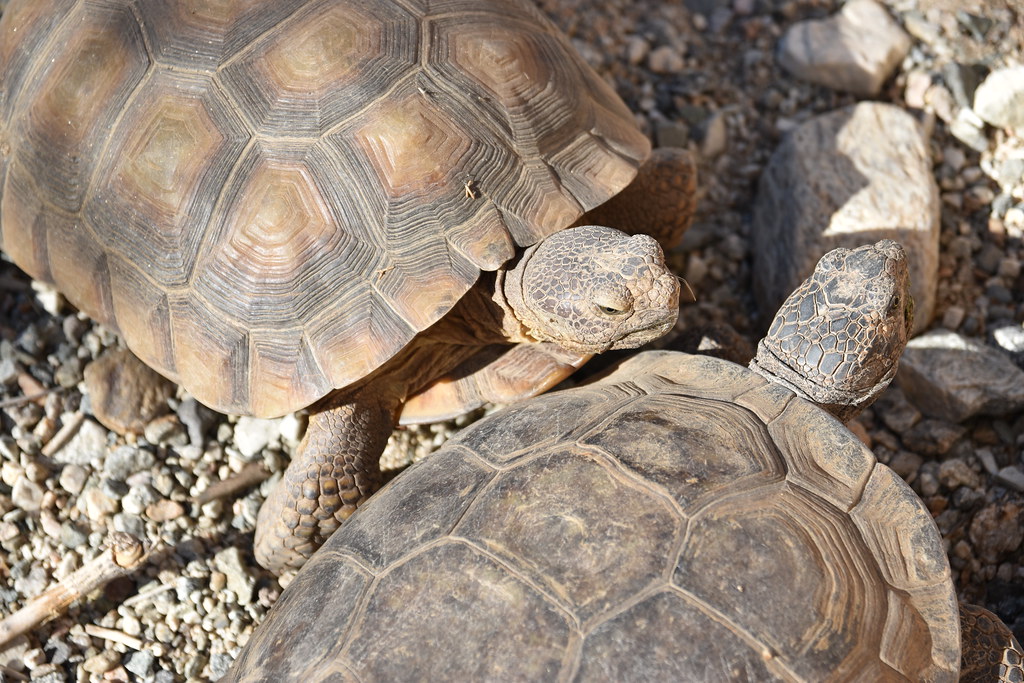
Image Source: Flickr
Desert tortoises have always captivated our fascination. How long do they live? Amazingly, some can reach over 100 years! The average lifespan is between 50 to 80 years, making them one of the longest-lived reptiles.
Their unique traits help them adapt to harsh climates. They can conserve water and withstand extreme temperatures. Burrows and rocky crevices protect them from the heat. Plus, a slow metabolic rate helps them go without food or water for long periods.
To ensure their longevity, we must take action. Protect their natural habitat from destruction. Conservation efforts should focus on preserving ecosystems and limiting human impact.
Education is key too. We must teach people about respecting wildlife and conserving biodiversity. Showing future generations the importance of desert tortoises helps ensure their survival for years to come.
Key Takeaways
- Desert tortoises have a long lifespan, with some individuals living up to 80 years or more.
- The lifespan of desert tortoises can vary depending on various factors such as habitat, diet, and overall health.
- These tortoises have adapted to survive in harsh desert environments, which contributes to their longevity.
- Conservation efforts are crucial to protect desert tortoises and their habitats, as they are considered a threatened species.
- Understanding the lifespan of desert tortoises can help researchers and conservationists develop effective strategies for their protection and management.
Understanding the Natural Habitat of Desert Tortoises
To understand the natural habitat of desert tortoises and optimize their longevity, delve into the vital aspects of their environment. Explore the impacts of climate and environment, along with the significance of diet and nutrition for the well-being of these fascinating creatures.
Climate and Environment
Climate and environment are essential for desert tortoises’ natural habitats. Let’s explore what makes their climate and environment unique!
Temperature: Hot, up to 140°F (60°C) in summer.
Precipitation: Rare, usually less than 10 inches per year.
Vegetation: Sparse, mainly cacti, shrubs, and grasses.
Elevation: From sea level to high mountain regions.
They have adapted for arid surroundings by storing water in their bladders. This adaptation is remarkable! To help them survive sustainably, here are some tips:
- Create artificial shade – reduce exposure to sunlight and maintain suitable microclimates.
- Implement water conservation – vital to preserve the ecosystem.
- Protect habitats – limit human encroachment and minimize destruction.
These suggestions work because they tackle desert tortoises’ challenges. Shade structures reduce heat stress, water conservation preserves resources, and protecting habitats safeguards the ecosystem.
By understanding their climate and environment, we can take steps to ensure desert tortoises’ long-term conservation and wellbeing. Let us continue to respect and protect them in their home!
Diet and Nutrition
Desert tortoises are herbivores and eat a variety of grasses, forbs, cacti, and succulents. These plants provide the necessary nutrients, water content, and fiber for their digestive system. Desert tortoises have adapted to survive in arid environments. They mostly get hydration from the plants they eat, and their kidneys help conserve water.
It is crucial to understand the dietary needs of desert tortoises. By protecting their habitats with enough vegetation and diverse plant species, we can safeguard their future. We must act now to preserve their natural habitat and secure an ecosystem that embraces the beauty of these remarkable tortoises. Together, we can make a difference so that these incredible creatures can live in the desert forever.
Lifespan of Desert Tortoises
To understand the lifespan of desert tortoises, delve into the factors affecting their longevity and compare their average lifespan in captivity with that in the wild. These sub-sections provide a comprehensive solution to grasp the nuances of desert tortoises’ lifespan and the impact of different environments on their longevity.
Factors Affecting Lifespan
Desert tortoises need us to understand the factors that affect their lifespan. These factors include:
- Environmental conditions, such as temperature changes, water sources, and habitat quality, which have a big impact on their survival.
- Predation and human interference, including predators like coyotes and ravens, as well as off-road vehicles and habitat destruction, which can threaten them.
- Diet and nutritional intake, with nutritious plants like cactus pads and wildflowers being important components. Poor nutrition weakens their immune system and leaves them open to disease.
- Genetics and biological factors, which also influence their lifespan.
To give them the best care, it is important to ensure their environment is similar to their natural one and to feed them a balanced diet full of native vegetation. By understanding these factors, we can help ensure their longevity.
Average Lifespan in Captivity vs. the Wild
The average lifespan of desert tortoises in the wild and captivity varies greatly. Let’s compare the two scenarios.
In Captivity: 20-30 years
In the Wild: 50-80 years
Captive tortoises have a shorter lifespan, likely due to artificial environments and limited resources. In the wild, they are free to roam and interact with their natural habitat, allowing them to live longer.
In captivity, tortoises may experience limited space and diet options, resulting in reduced health and lifespan. Historically, desert tortoises have adapted to arid conditions, allowing for long survival in the wild.
Tortoise care is both slow and steady – you must have the patience of a saint or the speed of a hare to be a caretaker.
Taking Care of Desert Tortoises

To ensure the well-being of desert tortoises, providing the right shelter and heat, ensuring proper feeding and hydration, and attending to their health and veterinary care are essential. Each of these sub-sections holds the key to maintaining the longevity and health of these fascinating creatures.
Providing the Right Shelter and Heat
Sandy, a desert tortoise, was rescued from an illegal pet trade. She was brought to a sanctuary where she received the necessary shelter and heat. Eventually, her health improved, showing the importance of providing the proper environment for these creatures.
To create a suitable shelter for desert tortoises, it’s important to build a spacious enclosure with secure walls and a covered area to protect them from extreme weather. Additionally, heat lamps or basking spots should be provided to maintain the right temperature. And, ventilation is key, so screened windows or openings should be included for good air flow.
Overcrowding should be avoided when housing multiple desert tortoises together, as this can lead to stress and territorial conflicts. As for feeding and hydration, it’s important to keep them nourished, but without the satisfaction of tasting their creations.
Feeding and Hydration
Feeding and hydration are vital for desert tortoise well-being. Provide a balanced diet and clean water for them. Leafy greens, vegetables, fruits, and hay are excellent sources of nutrition. Moderation is key for fruit due to sugar content. High-quality grass hay ensures fiber. Avoid iceberg lettuce, spinach, and broccoli as they can cause digestive issues. Don’t overfeed as obesity can lead to health problems. Give fresh water in a shallow container. Monitor and refill during hot weather or when active. No fancy health insurance needed – these tortoises have been surviving in the desert for centuries!
Health and Veterinary Care
Desert tortoises need proper care to stay healthy. Here are some tips to remember:
- Check-ups: Book regular appointments with a reptile vet who knows about desert tortoises. They can check their health and make sure they’re vaccinated.
- Food: Make sure they have a balanced diet. Ask a vet what mix of fruit, veg and calcium is best.
- Habitat: Get the right lighting and temperature. Create a place with both warmth and shade.
- Parasites: Desert tortoises can get parasites. Do regular poo checks to make sure.
Plus, desert tortoises need:
- A natural habitat. Like, sand or soil to feel like home.
- To be alone. Male tortoises will fight if kept together.
To keep your desert tortoise happy:
- Choose a vet with reptile expertise.
- Check the temperature and humidity.
- Give them fresh water every day.
- Let them exercise and have fun.
By following these tips, your desert tortoise will be safe and happy. Nutrition, check-ups, the right home, and parasite prevention are all important.
Ensuring the Longevity of Desert Tortoises
To ensure the longevity of desert tortoises, address various aspects of their care. Proper handling and interaction, protection from predators, and conservation efforts play crucial roles in safeguarding these incredible creatures.
Proper Handling and Interaction
It’s essential to handle desert tortoises properly to ensure their long life. Follow these guidelines to keep them safe and happy:
- Move slowly and carefully when approaching a tortoise, without any sudden movements.
- Only touch a tortoise if it’s necessary, as it can distress them.
- When handling a tortoise, support its weight with both hands.
- Never lift a tortoise by its shell, as it can be injurious.
- Handle the tortoise for as short a time as possible and then let it go back to its habitat.
- Don’t release captive tortoises into the wild, contact proper authorities for guidance on rehoming.
Also, desert tortoises have specific behaviours and requirements. They are temperature-sensitive, so provide them with shady areas to imitate their natural environment. Feed them with a balanced diet of fruits and vegetables to maintain their nutrition.
In addition, take extra precautions to keep desert tortoises safe:
- Don’t use pesticides or hazardous chemicals near their habitats.
- Keep pets away from where they live.
- Clean their enclosures often.
- Educate other people about the significance of respecting and protecting tortoises.
By following these tips, we can guarantee desert tortoises a long life while respecting their natural habitats and needs. Together, we can work to preserve these incredible creatures for years to come.
Protection from Predators
Desert tortoises use intriguing strategies to protect themselves from predators. These techniques are vital to their success in the tough desert environment. They can retract their heads, limbs, and tail into their shell. This defense saves them from danger and helps them escape predators.
Camouflage is another important strategy. Their colors blend with the surroundings, making it hard for predators to find them. This camouflage is significant for concealment and safety.
The desert tortoises also have a great sense of hearing. They can detect vibrations and sounds that may mean a predator is near. This sharp awareness lets them take immediate action and seek shelter.
Burrowing is one more defense they use. By digging burrows, they create safe havens to hide in when threatened. These burrows protect them against predators, extreme temperatures, and other environmental risks.
Plus, desert tortoises have an amazing resistance to dehydration. They can store water in their bladder, helping them survive when there is a lack of water. This adaptation allows them to stay hidden in their burrows without food for long periods.
These unique features show the extraordinary adaptations desert tortoises have developed to protect themselves from predators in their tough habitat.
Conservation Efforts
Conservation measures are super-important for keeping desert tortoises around for a long time. To safeguard these majestic creatures, various initiatives have been put into action.
- Habitat protection: Creating and maintaining protected zones makes sure desert tortoises have a safe space to live.
- Educating people: Teaching others about the importance of conserving desert tortoise habitats raises awareness and support.
- Species tracking: Regular monitoring helps scientists track population numbers and spot any problems that need solving.
- Captive breeding: Breeding programs increase natural populations, ensure genetic diversity and protect against extinction risks.
We’re taking steps to reduce human activity that affects desert tortoises. By reducing vehicle use and urbanization’s impact, these iconic reptiles get more protection.
Did you know? In 1972, the Desert Tortoise Habitat Conservation Plan was designed to guard essential areas and ensure the survival of this endangered species. This plan has been an important part in guiding conservation efforts and promoting collaboration between different groups.
By making an effort, we can guarantee a bright future for desert tortoises and keep their unique role in our environment. So, if desert tortoises live longer than their peers, why not take a few tips from them? Or hire a tortoise trainer!
Frequently Asked Questions
Q: How long do desert tortoises live?
A: Desert tortoises have a long lifespan, with individuals living for 50 to 80 years on average. However, some desert tortoises have been known to live for over 100 years.
Q: What factors can affect the lifespan of desert tortoises?
A: The lifespan of desert tortoises can be influenced by various factors. These include habitat conditions, availability of food and water, predation risk, and overall health. Proper care and conservation efforts can also have a positive impact on their longevity.
Q: How do desert tortoises adapt to survive in their harsh environment?
A: Desert tortoises have several adaptations that enable them to survive in their arid habitat. They have the ability to store water in their bladder, can tolerate high internal temperatures, and burrow to escape extreme heat. They also have specialized kidneys that efficiently conserve water.
Q: What threats do desert tortoises face?
A: Desert tortoises face a range of threats, including habitat loss due to urbanization and land development, fragmentation of their habitat, illegal collection for the pet trade, and predation by non-native species. Climate change and diseases, such as the upper respiratory tract disease, also pose significant risks to their survival.
Q: Are desert tortoises protected by law?
A: Yes, desert tortoises are protected by various laws and regulations. They are listed as a threatened species under the U.S. Endangered Species Act, and it is illegal to harm, collect, or harass them without the proper permits. It is important to respect these protections and avoid disturbing their natural habitat.
Q: How can I help conserve desert tortoises?
A: There are several ways you can contribute to the conservation of desert tortoises. These include supporting organizations that work towards their protection, reporting illegal activities involving desert tortoises, educating others about their importance, and promoting responsible land and habitat management practices.
Conclusion
Desert tortoises have a remarkable lifespan. They can live over 50 years in the wild. Factors like their ability to store water and endure drought help them survive. Plus, they keep growing throughout their lives. This helps them adapt to their desert habitats.
These creatures are also resilient. They can go without water and enter a state of dormancy called aestivation in dry periods. One amazing example of their endurance is Solstice. He was shot several times, but survived. Later, he was found eight miles away from where he was released! This illustrates the power of conservation in protecting the desert tortoise’s habitat.
References




